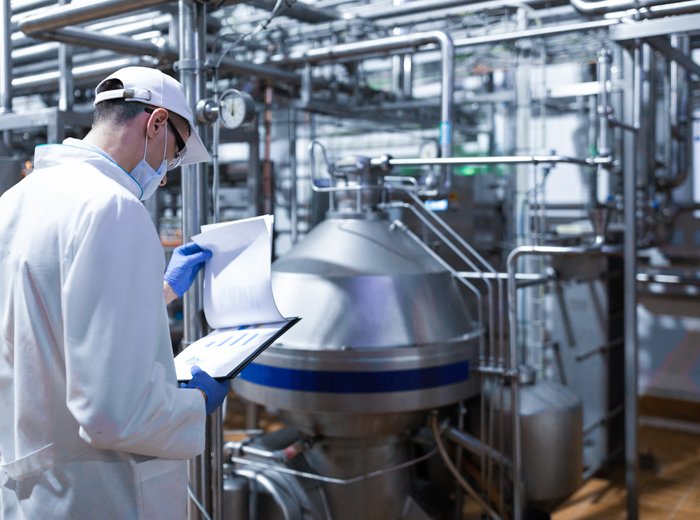Typical pH Measurement Challenges in The Food and Beverage Industry
583 Views |

การวัดค่า pH ถูกใช้ในกระบวนการทางอุตสาหกรรมมากมาย เพื่อตรวจสอบคุณภาพผลิตภัณฑ์ เพิ่มประสิทธิภาพของกระบวนการ และช่วยให้แน่ใจถึงความปลอดภัยของโรงงาน ไปจนถึงการติดตามตรวจสอบน้ำเสีย ซึ่งที่ผ่านมาเซนเซอร์ pH แบบกระเปาะแก้วนั้นให้ประสิทธิภาพในการตรวจวัดที่เชื่อถือได้มากที่สุด อย่างไรก็ตาม ปัญหาของเซนเซอร์ pH แบบกระเปาะแก้วนั้น ก็คือความต้องการในการสอบเทียบบ่อยครั้งและความแข็งแรงทนทาน นั่นเอง
การบำรุงรักษาเซนเซอร์ pH อย่างสม่ำเสมอจึงเป็นสิ่งจำเป็นสำหรับการรักษาความน่าเชื่อถือในการตรวจวัด ซึ่งมีข้อควรปฏิบัติ เช่น การทำความสะอาดเพื่อป้องกันการเกิดคราบ และการสะสมของสิ่งที่สามารถรบกวนประสิทธิภาพการทำงานของเซ นเซอร์ และการสอบเทียบเพื่อแก้ไขการวัดที่คาดเคลื่อน เป็นต้น นอกจานกนี้ การสัมผัสกับอุณหภูมิสูงจาก CIP (Cleaning-in-Place ) และ/หรือสภาวะยากลำบาก ก็นับเป็นอีกปัจจัยที่ทำให้เกิดการคาดเคลื่อนของสัญญาณการวัดค่าใน เซนเซอร์ pH และยังทำให้ต้องการการบำรุงรักาที่มากกว่าเดิม ซึ่งการบำรุงรักษาเซนเซอร์บ่อยครั้งนั้นย่อมหมายถึงต้นทุนจากการดำเนินการที่สูงมากขึ้นด้วย
ความเสียหายของเซนเซอร์ pH ในกรณีที่เกิดการแตกหักนั้นสามารถสร้างความเสียหายได้มากมาย อย่างน้อยก็ทำให้ไลน์การผลิตต้องหยุดลง แต่หากโชคร้ายก็ก็อาจทำให้ต้องมีการทำงานซ้ำอีกครั้งซึ่งมีต้นทุนสูง หรือบางครั้งอาจจะถึงขั้นต้องทิ้งผลิตภัณฑ์ในสายการผลิตทั้งหมด เนื่องจากเสี่ยงต่อการปนเปื้อนเศษแก้ว ซึ่งในภาคอุตสาหกรรมอาหารและเครื่องดื่ม การใช้เซนเซอร์ pH แบบกระเปาะแก้วนั้นสามารถทำได้แค่เพียงบางจุดที่ไม่สำคัญและไม่มีความเสี่ยงในกระบวนการผลิตเท่านั้น
ไม่มีความเสี่ยงจากการปนเปื้อนแก้ว
เพื่อตอบสนองความท้าทายของอุตสาหกรรมอาหารและเครื่องดื่ม เทคโนโลยีใหม่สำหรับการวัดค่า pH จึงถูกพัฒนาขึ้น โดยชิปรุ่นใหม่ล่าสุดนี้ ซึ่งผลิตจากวัสดุที่มีความแข็งแรงทนทาน และยังคุณสมบัติด้านแรงเสียดทานเชิงกลที่ยอดเยี่ยม พร้อมด้วยการ ใช้หลักการวัดค่าศักย์ไฟฟ้าเช่นเดียวกับที่ใช้ในเซนเซอร์แก้ว ซึ่งไวต่อค่า pH ด้วย นอกจากนี้ ตามปกติในเซนเซอร์ pH พื้นผิวของชิป X-Chip นั้นสัมผัสกับสารละลายที่จะตรวจวัด เช่นเดียวกับเซนเซอร์แบบเดิม ๆ ชิปรุ่นใหม่ ยังมีชั้นเจลเพื่อให้ไอออน H+ สามารถแพร่กระจายได้ เหมือนกับในเซนเซอร์แก้วแบบเดิม ซึ่งจะสร้างระดับประจุไฟฟ้าโดยขึ้นกับค่า pH ของตัวกลาง (ศักย์ไฟฟ้าของพื้นผิวนี้แปรผันตามค่า pH ของสารละลายที่วัดค่า) เพื่อให้สามารถทำการวัดค่าที่เชื่อถือได้สูงสุด ขณะที่พื้นผิวภายในของชั้นที่ไวต่อค่า pH ของเซนเซอร์นั้นจะต้องได้รับการรักษาให้มีค่าศักย์ไฟฟ้าที่เสถียร เพื่อให้ความต่างศักย์ระหว่างพื้นผิวทั้งสองขึ้นกับค่า pH ของสารตัวกลางที่วัดค่าเพียงอย่างเดียว โดยในเซนเซอร์แบบดั้งเดิมการทำให้ศักย์ไฟฟ้าคงที่นั้นจะต้องมีขั้นตอนการเติมสารบัฟเฟอร์ภายในกระเปาะแก้วเพื่อรักษาค่า pH ให้คงที่
pH measurement is used in a plethora of industrial processes for monitoring product quality, increasing process efficiency, ensuring plant safety or monitoring wastewater. Until recently, glass-bulb pH sensors provided the most reliable measurement performance. However, challenges with glass electrodes correlated with their need for frequent calibration and poor mechanical strength has limited their use in the production of beverages, dairy products and other foods.
Regular maintenance of pH sensors is necessary for maintaining measurement reliability: cleaning to prevent fouling and buildup of material that can interfere with sensor performance, and calibration to correct for measurement drift. It is exposure to high temperatures (cleaning-in-place) and/or harsh conditions that cause the most drift of a pH sensor’s measurement signal, therefore shortening required maintenance intervals. The more often maintenance on sensors is performed, the higher the operating costs.
A pH sensor failure due to glass breakage will, in the best case, cause production downtime. At worst it can lead to expensive rework or even discarding of an entire production batch because of contamination of the product with glass splinters. Understandably, in the food and beverage industry, the use of in-line glass electrodes is only permitted in non-critical processes.
No Risk of Glass Contamination
As a response to industry challenges, METTLER TOLEDO has developed a new technology for measuring pH which is the technology chip a fully solid pH sensing element with exceptional mechanical resistance. The newly invented chip for pH sensor uses the same potentiometric measurement principle as pH-sensitive glass normally used in pH sensors. The surface of the chip1 is in contact with the measuring solution. Here, as in traditional electrodes, a gel layer forms where H+ ions can diffuse, creating a charge the level of which is dependent on the pH value of the medium (the potential of this surface is proportional to the pH of the measurement solution). In order to have a reliable measurement, the inner surface of the sensor’s pH-sensitive layer has to be kept at a stable potential, this way the difference in potential between the two surfaces is only dependent on the pH value of the measurement media. In traditional electrodes this fixed potential is achieved by filling the glass bulb with an inner buffer which maintains a constant pH value.
การวัดค่า pH คือการตรวจสอบคุณภาพที่สำคัญในอุตสาหกรรมอาหาร ไม่ว่าจะเป็นคุณภาพของวัตถุดิบ ผลิตภัณฑ์อาหาร หรือแม้แต่น้ำที่ทิ้งออกจากการผลิตก็ต้องมีการวัด pH ก่อน อย่างไรก็ตาม อุปกรณ์ที่ใช้ตรวจสอบแบบดั้งเดิมนั้น ยังมีข้อจำกัดอยู่บ้าง การเลือกเทคโนโลยีการวัด pH ที่ทันสมัยจะลดข้อจำกัดได้
pH calculation is one of the important qualifications in food industry for raw materials, final products, and wastewater. However original pH meter has some restriction, that’s why technology of pH meter is play a role.



